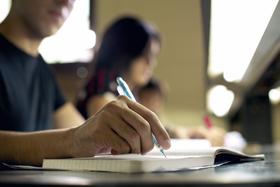Bristol-Plymouth Regional Technical School is a vocational high school located in Taunton, Massachusetts, United States, that has been in operation since September 1972. Bristol-Plymouth is one of the three high schools in the city of Taunton, and enrolls roughly 1,200 students in grades 9 through 12.
Serving 1,330 students in grades 9-12, Bristol-plymouth Vocational Technical ranks in the top 50% of all schools in Massachusetts for overall test scores (math proficiency is top 50%, and reading proficiency is top 50%).
The percentage of students achieving proficiency in math is 53% (which is higher than the Massachusetts state average of 42%). The percentage of students achieving proficiency in reading/language arts is 48% (which is higher than the Massachusetts state average of 44%).
The student-teacher ratio of 13:1 is higher than the Massachusetts state level of 12:1.
Minority enrollment is 19% of the student body (majority Hispanic), which is lower than the Massachusetts state average of 47% (majority Hispanic).
Quick Facts (2025-26)
- School Type: Vocational school
- Grades: 9-12
- Enrollment: 1,330 students
- Student-Teacher Ratio: 13:1
- Minority Enrollment: 19%
- Graduation Rate: 96% (Top 20% in MA)
- Overall Testing Rank: Top 50%
- Math Proficiency: 53% (Top 50%)
- Reading Proficiency: 48% (Top 50%)
- Science Proficiency: 41% (Btm 50%)
- Source: National Center for Education Statistics (NCES), MA Dept. of Education
Top Rankings
Bristol-plymouth Vocational Technical ranks among the top 20% of public schools in Massachusetts for:
Category
Attribute
Graduation Rate
School Overview
Bristol-plymouth Vocational Technical's student population of 1,330 students has stayed relatively flat over five school years.
The teacher population of 104 teachers has grown by 7% over five school years.
School Type
Grades Offered
Grades 9-12
(Supplemental Virtual)
(Supplemental Virtual)
Total Students
1,330 students
Gender %
Total Classroom Teachers
104 teachers
Year Founded
1972
Colors
Blue, Navy Blue, Sky Blue, Silver
School Calendar
Last Day of School
Tue. Jun 30, 2026
School Motto
Building for the Future
School Rankings
Bristol-plymouth Vocational Technical ranks within the top 50% of all 1,626 schools in Massachusetts (based off of combined math and reading proficiency testing data).
The diversity score of Bristol-plymouth Vocational Technical is 0.34, which is less than the diversity score at state average of 0.65. The school's diversity has stayed relatively flat over five school years.
Overall Testing Rank
#590 out of 1626 schools
(Top 50%)
(Top 50%)
Math Test Scores (% Proficient)
53%
42%
Reading/Language Arts Test Scores (% Proficient)
48%
44%
Science Test Scores (% Proficient)
41%
44%
Student-Teacher Ratio
13:1
12:1
American Indian
n/a
n/a
Asian
1%
7%
Hispanic
8%
25%
Black
6%
10%
White
81%
53%
Hawaiian
n/a
n/a
Two or more races
4%
5%
All Ethnic Groups
Graduation Rate
96%
90%
Participates in the National School Lunch Program (NSLP)
Yes
Eligible for Free Lunch
30%
35%
Eligible for Reduced Lunch
7%
4%
School Statewide Testing
School District Name
Source: National Center for Education Statistics (NCES), MA Dept. of Education
School Notes
- School Mascot: Eagle
Profile last updated: 02/09/2025
Frequently Asked Questions
What is Bristol-plymouth Vocational Technical's ranking?
Bristol-plymouth Vocational Technical is ranked #590 out of 1,626 schools, which ranks it among the top 50% of public schools in Massachusetts.
What schools are Bristol-plymouth Vocational Technical often compared to?
Bristol-plymouth Vocational Technicalis often viewed alongside schools like Diman Regional Vocational Technical High School by visitors of our site.
What percent of students have achieved state testing proficiency in math and reading?
53% of students have achieved math proficiency (compared to the 42% MA state average), while 48% of students have achieved reading proficiency (compared to the 44% MA state average).
What is the graduation rate of Bristol-plymouth Vocational Technical?
The graduation rate of Bristol-plymouth Vocational Technical is 96%, which is higher than the Massachusetts state average of 90%.
How many students attend Bristol-plymouth Vocational Technical?
1,330 students attend Bristol-plymouth Vocational Technical.
What is the racial composition of the student body?
81% of Bristol-plymouth Vocational Technical students are White, 8% of students are Hispanic, 6% of students are Black, 4% of students are Two or more races, and 1% of students are Asian.
What is the student-teacher ratio of Bristol-plymouth Vocational Technical?
Bristol-plymouth Vocational Technical has a student ration of 13:1, which is higher than the Massachusetts state average of 12:1.
What grades does Bristol-plymouth Vocational Technical offer ?
Bristol-plymouth Vocational Technical offers enrollment in grades 9-12 (Supplemental Virtual).
What school district is Bristol-plymouth Vocational Technical part of?
Bristol-plymouth Vocational Technical is part of Bristol-Plymouth Regional Vocational Technical School District.
School Reviews
Review Bristol-plymouth Vocational Technical. Reviews should be a few sentences in length. Please include any comments on:
- Quality of academic programs, teachers, and facilities
- Availability of music, art, sports and other extracurricular activities
Recent Articles

School Vouchers: Updated Pros and Cons (2025 Review)
Comprehensive 2025 analysis of school vouchers, weighing benefits and challenges for families, funding, outcomes, and policy directions.

Benefits and Drawbacks of Homework in 2025
Explore updated 2025 insights on homework’s benefits, drawbacks, mental health impact, best practices, and policy trends in U.S. public schools.

Charter Schools vs Public Schools 2025: Key Differences & Trends
Explore updated 2025 insights comparing charter schools vs public schools, enrollment, academic outcomes, funding, and real-world examples for families and educators.





